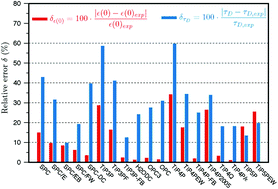Temperature-dependence of the dielectric relaxation of water using non-polarizable water models†
Abstract
Key physical and chemical properties of aqueous fluids are determined by the structure and dynamics of the hydrogen bond network of water but we lack adequate models for the linkages between hydrogen bonding and aqueous chemistry, particularly in non-ambient conditions or in confinement. Dielectric relaxation spectroscopy (DRS) provides a sensitive approach for probing water dynamics but sound interpretation of DRS data requires molecular simulation and associated computational methods capable of accurately representing aqueous fluids and their frequency dependent, complex permittivity. Here, we test the accuracy of dielectric spectra of bulk liquid water calculated from molecular dynamics simulations using 19 non-polarizable water models at 298 K. In contrast to prior studies, the simulation size, time-step and duration allow calculation of the dielectric function from 107–1012 Hz without assuming an analytical form. The accuracy of the prediction of the low-frequency (static) dielectric constant at room temperature is related to the water molecule dipole moment, specifically models with μ ≥ 2.4 D give ε(0) with a relative error lower than 5%. However, no water model tested can fully reproduce the complex dielectric spectra of water. For a subset of models, calculations of the dielectric response from −5 to 60 °C reproduces the experimental trend in water dynamics with temperature but the characteristic relaxation time is always underestimated. The calculated water dipole relaxation time and hydrogen-bond lifetime are both exponentially decaying functions of temperature, and exhibit a linear correlation very close to equality. The comparison provides new computational support for the concept that the Debye relaxation of liquid water is determined by the dynamics of the hydrogen-bond network, and that both are ensemble properties.



 Please wait while we load your content...
Please wait while we load your content...
